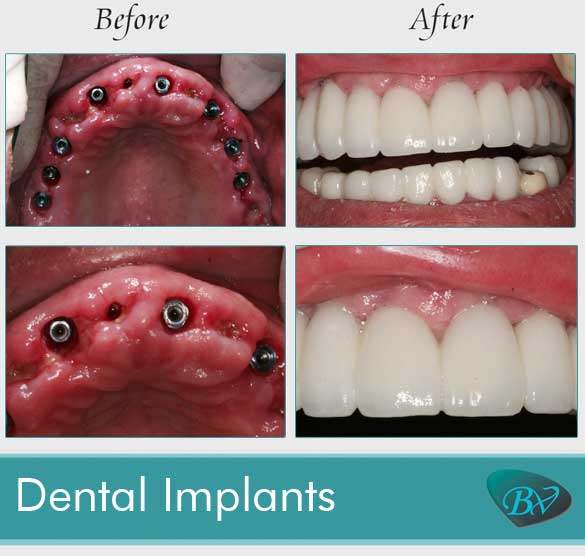Examine This Report about Dental Sense
Table of ContentsHow Dental Sense can Save You Time, Stress, and Money.The 30-Second Trick For Dental SenseOur Dental Sense DiariesDental Sense - An Overview
are medical gadgets operatively dental implanted into the jaw to recover an individual's capability to chew or their look. They supply support for synthetic (phony) teeth, such as crowns, bridges, or dentures. When a tooth is shed because of injury or illness, a person can experience issues such as fast bone loss, malfunctioning speech, or changes to eating patterns that lead to pain.Dental implant systems include a dental implant body and dental implant joint and may also consist of an abutment fixation screw. Same day dental implants. The oral implant body is surgically put in the jawbone instead of the tooth's root. The oral implant joint is normally connected to the implant body by the abutment fixation screw and extends through gum tissues right into the mouth to sustain the connected artificial teeth
(https://sitereport.netcraft.com/?url=https://nearme.vip)Framework of The Dental Implant System selecting dental implants, speak with your oral service provider about the potential advantages and dangers, and whether you are a prospect for the treatment. Things to think about: Your general health and wellness is a vital factor in determining whether you are an excellent prospect for oral implants, just how long it will certainly require to heal, and for how long the implant may remain in place.
Smoking may affect the recovery procedure and reduce the long-lasting success of the dental implant. The recovery process for the dental implant body may take a number of months or longer, during which time you usually have a short-term joint in location of the tooth. the dental implant treatment: Thoroughly adhere to the oral health instructions provided to you by your oral supplier.
Dental Sense Fundamentals Explained
Implant failure can cause the need for another operation to deal with or replace the implant system. Brings back the ability to eat Brings back cosmetic appearance Helps maintain the jawbone from reducing because of bone loss Preserves the health of the bordering bone and periodontals Assists maintain nearby (close-by) teeth steady Improves lifestyle Damage to surrounding natural teeth during dental implant placement Injury to the surrounding cells during surgery, such as sinus opening Injury throughout surgery (for instance, crack of bordering jawbone) Poor function, such as really feeling like the teeth do not bite with each other generally A sensation that the tooth is loose or turning in location resulting from a joint screw loosening Implant body failing (looseness of the implant body) due to systemic infection, which may be most likely in clients with uncontrolled diabetes as a result of local infection in bone and gums sustaining the implant body as a result of delayed recovery, which may be most likely in people who smoke Difficulty cleaning up the gum tissues around the implant, causing bad oral health Without treatment periodontal condition Post-surgical feeling numb due to nerve impingement or damage Constantly notify health and wellness treatment providers and imaging professionals that you have oral implants before any type of magnetic vibration imaging (MRI) or x-ray procedures.
FDA is not aware of any kind of unfavorable events reported for MRI or x-ray treatments with dental implants. Oral implants systems are normally made of materials that follow worldwide consensus criteria of the International Organization for Standardization (ISO) or ASTM International. These standards have information of what makes a risk-free material.

A dental implant is a framework that replaces a missing tooth. With screw-like devices, the surgeon inserts an implant into the jawbone, and it acts as a support for a man-made tooth, called a crown. A gadget called an abutment links the artificial tooth to the oral implant. The crown is customized to fit the person's mouth and match the color of their teeth.
Dental Sense - Questions
Some people are not qualified for dental implant surgery. It is for oral cosmetic surgeons to operate individuals with: severe illnessuncontrollable metabolic diseasebone or soft cells illness or infectionIf these issues are dealt with, a person can have the surgical procedure. In, dental specialists refrain from operating people with: If individuals with any one of the above undergo dental implant surgical procedure, there is a greater risk of the implant the original source failing.

Oral implant surgical treatment is a personalized process. It's not the very same for everyone. Yet the adhering to offers a general review of what you can expect your dental professional, oral specialist, periodontist or prosthodontist to do: Position the implant operatively. Give you time to recover. Attach the message and last crown, bridge or denture.
Next, your specialist will carefully position the dental implant into your jaw. If your implant is near the front of your mouth, your dental expert will make a momentary tooth for you to wear until you recover.
The Best Guide To Dental Sense
Your copyright can tell you what to expect in your circumstance. During the healing phase, your jawbone needs to fuse to the oral implant. This process, called osseointegration, is vital for security and long-lasting success. This procedure can take anywhere from three to nine months. In some cases, it might take longer.
When your implant heals, your dentist can attach the joint (tiny adapter message) and your last remediation (crown, bridge or denture). This typically takes regarding one hour to finish and might need a second minor surgical procedure. You shouldn't really feel any type of pain during your oral implant treatment since your service provider will utilize drug to numb your gum tissues.